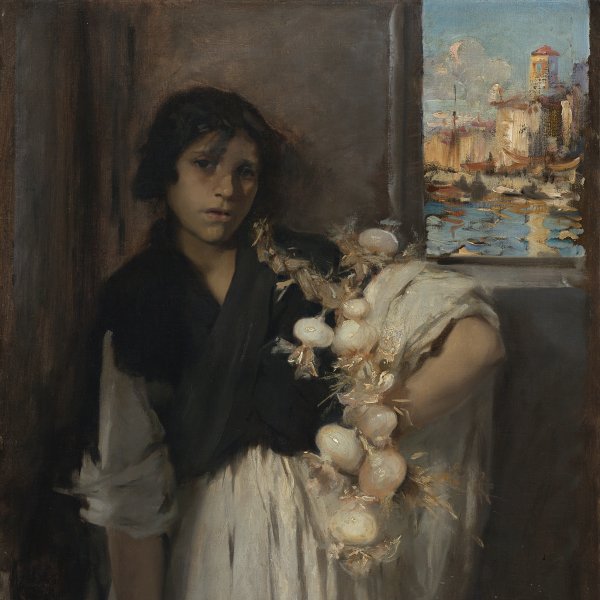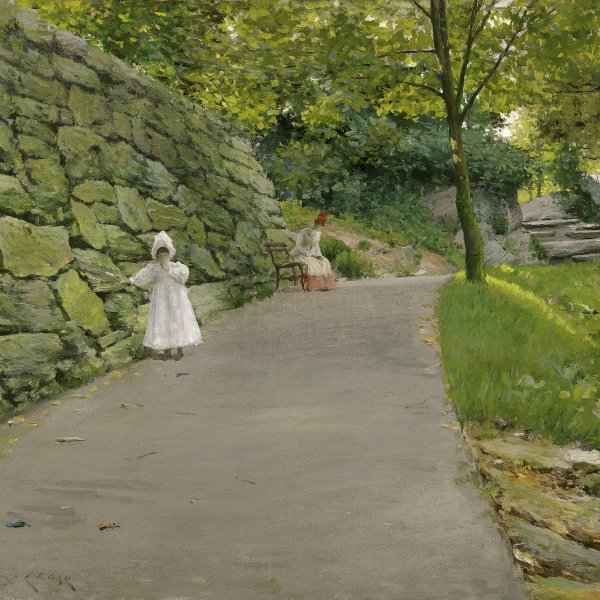The Rainbow, Autumn, Catskill
ca. 1880 - 1890
Oil on canvas.
29.2 x 42.8 cm
Carmen Thyssen Collection
Inv. no. (
CTB.1999.114
)
Not on display
Level 2
Permanent Collection
Level 1
Permanent Collection
Level 0
Carmen Thyssen Collection and Temporary exhibition rooms
Level -1
Temporary exhibition rooms, Conference room and EducaThyssen workshop
Worthington Whittredge, unlike most of the painters associates with the Hudson River School, received his training in Europe from artists associated with the Düsseldorf Academy in Germany. His development as an artist was influenced by Andreas Achenbach, Carl Friedrich Lessing, and Johann Schirmer. Returning to America in 1859, Whittredge was acutely aware of the differences between the landscapes of the Old World and America. He visited The New York Historical Society shortly after landing in New York and saw that the landscapes of the established American painters, especially the works of Asher B. Durand, differed from the European models on which his art had been built. And the physical American landscape, he quickly re-discovered on a sketching excursion to the Catskills, was also far different from the terrain he had experienced in Europe. "The forest was a mass of decaying logs and tangled brush wood, no peasants to pick up every vestige of fallen sticks to burn in their miserable huts, no well-ordered forests, nothing but the primitive woods with their solemn silence reigning everywhere." Whittredge realised that if he were to succeed as an American painter, he must "produce something new and which might claim to be inspired by my home surroundings." In his 1867 evaluation of the artist, Henry T. Tuckerman, America's foremost art critic at mid-19th-century, agreed that with the artist's rediscovery of the unique qualities of the American landscape, he found his distinct subject: "Worthington is a progressive artist; he acquired with the dexterity, some of the mannerism of the Düsseldorf school; but constant and loving study of nature, since his return from abroad, has modified this habitude; he is more original, and applies his skill with deeper sentiment; conscientiously devoted to his art, for manly fidelity to the simple verities of nature, no one of our painters is more consistently distinguished than Worthington Whittredge."
After journeying to the western United States in 1867-1870, where he was impressed by the vastness of the plains, Whittredge returned to painting the landscape of New England and the Catskill region of New York. In his forest interiors he gradually adopted a looser, more Barbizon manner, which was concerned with the mood and tonal qualities of the woodland landscapes. He felt that the Catskills displayed a variety of scenery with "peculiar characteristics" not found in other areas. This quality is found in The Rainbow, Autumn, Catskills, a quiet woodland scene, its autumnal tones intensified by a passing shower. Below a rainbow breaking through the cloudy sky, Mallard ducks are seen floating upon the placid stream. John Ferguson Weir wrote in 1876 that Whittredge's forest interiors which are "loose, free, sketchy, void of all that is rigid and formal" evince "a subtle sympathy with the suggestive and evanescent qualities of the landscape."
The motif of waterfowl in the centre foreground of his composition was used by Whittredge as early as 1864 in his painting, Duck Pond. On the other hand, a larger, almost exact replica of Rainbow, Autumn, Catskills, bearing the title The Rainbow, was dated 1901 by the artist. While it has been claimed this canvas was exhibited at the National Academy of Design in 1875 as no. 445, After the Rain, there is no evidence to support this. Rather, the cursory, painterly treatment of The Rainbow, Autumn, Catskills -its title inscribed on the reverse of the canvas- suggests a date of the 1880s, a time Whittredge often returned to his woodland compositions of the 1870s.
Kenneth W. Maddox
After journeying to the western United States in 1867-1870, where he was impressed by the vastness of the plains, Whittredge returned to painting the landscape of New England and the Catskill region of New York. In his forest interiors he gradually adopted a looser, more Barbizon manner, which was concerned with the mood and tonal qualities of the woodland landscapes. He felt that the Catskills displayed a variety of scenery with "peculiar characteristics" not found in other areas. This quality is found in The Rainbow, Autumn, Catskills, a quiet woodland scene, its autumnal tones intensified by a passing shower. Below a rainbow breaking through the cloudy sky, Mallard ducks are seen floating upon the placid stream. John Ferguson Weir wrote in 1876 that Whittredge's forest interiors which are "loose, free, sketchy, void of all that is rigid and formal" evince "a subtle sympathy with the suggestive and evanescent qualities of the landscape."
The motif of waterfowl in the centre foreground of his composition was used by Whittredge as early as 1864 in his painting, Duck Pond. On the other hand, a larger, almost exact replica of Rainbow, Autumn, Catskills, bearing the title The Rainbow, was dated 1901 by the artist. While it has been claimed this canvas was exhibited at the National Academy of Design in 1875 as no. 445, After the Rain, there is no evidence to support this. Rather, the cursory, painterly treatment of The Rainbow, Autumn, Catskills -its title inscribed on the reverse of the canvas- suggests a date of the 1880s, a time Whittredge often returned to his woodland compositions of the 1870s.
Kenneth W. Maddox









